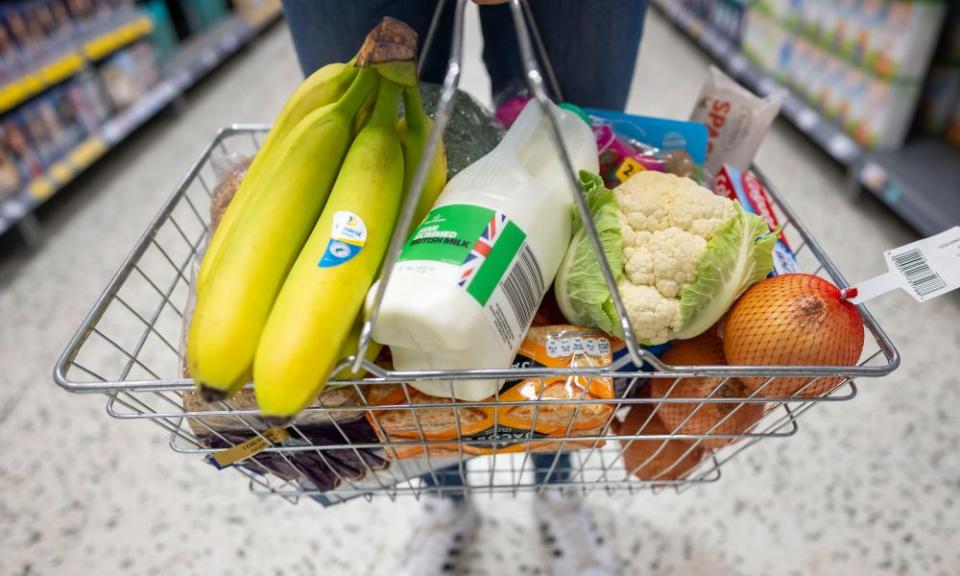UK food inflation dips in May, raising hopes rate of price growth is slowing

Food inflation in the UK fell in May, lifting hopes that the rapid increase in grocery price growth may have reached its peak after keeping the broader consumer prices index painfully high so far this year.
After more than a year of sharp increases in the price of food, the British Retail Consortium (BRC) said annual food inflation eased this month from 15.7% to 15.4%, even as the overall rise in shop prices hits a fresh high.
Fresh-food inflation, which has rocketing after spectacular increases in the price of sausages, milk, cheese and eggs, fell from 17.8% to 17.2%.
While the decrease in May was modest, the BRC said it indicated that food-price inflation had peaked and was beginning to come down.
The government is working on plans for a voluntary price cap on essential items such as bread and milk, but the proposal has been criticised by retail groups as ineffectual.
The Bank of England is among several forecasters to raise its estimate for inflation in response to predictions that food prices would remain elevated through the summer and autumn. It now expects inflation at the end of the year to be above 5% rather than the 3% or so it previously forecast.
The BRC chief executive, Helen Dickinson, said weaker retail prices were “largely driven by lower energy and commodity costs starting to filter through to lower prices of some staples”.
Dickinson said the price of butter, milk, fruit and fish had fallen after a recent trend that was accelerated by “fierce competition” among UK supermarkets. This had kept “British food among the cheapest of the large European economies”, she added.
The BRC represents a wide range of UK retailers, including the main supermarket chains.
Dickinson said a rise in the price of chocolate and coffee because of “high global costs for these commodities” prevented food inflation from falling further.
However, the BRC warned the government that Britain’s dependence on food imports from the rest of Europe meant that an incoming round of post-Brexit border controls could reverse the trend.
Dickinson said: “While there is reason to believe that food inflation might be peaking, it is vital that government does not hamper this early progress by piling more costs on to retailers and forcing up the cost of goods even further.
“The biggest risk comes from policies such as the incoming border checks and reforms to packaging recycling fees.”
Extended Producer Responsibility regulations mean the producers of packaging must pay the full cost of its recovery and recycling from April 2024. EPR is expected to cost retailers £2bn a year, the BRC said, several times the cost of the current system that will operate in tandem until 2027.
New labelling requirements under the Windsor agreement will also slow border checks, the BRC said.
The Bank of England is expected to increase interest rates from 4.5% to 4.75% when its monetary policy committee meets next month as it tries to bring down CPI inflation, which fell by less than expected in April to 8.7% after rising food prices and the cost of business services remained stubbornly high.
Dickinson said the fall in food inflation was offset by an increase in non-food prices despite “consumers benefiting from heavy discounts in footwear as well as books and home entertainment”.
Non-food inflation hit 5.8% in May, up from 5.5% in April and above the three-month average of 5.7%. Overall, retailers increased prices by 9%, up slightly from 8.8% in April, pushing shop price growth to a fresh high.
Mike Watkins, a spokesperson for the survey compiler NielsenIQ, said feedback from retailers showed that to help mitigate the impact of inflation, shoppers were “saving money by looking for seasonal promotions on the high street and taking advantage of the price reductions offered by supermarket loyalty schemes”.
He said: “Food retailing in particular is competitive, so hopefully the recent price cuts in fresh foods are a sign that inflation has now peaked.”
• The headline of this story was amended on 30 May 2023 to clarify that it was the rate of price growth, not prices, that was falling.

 Yahoo Finance
Yahoo Finance 